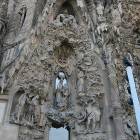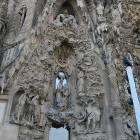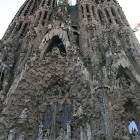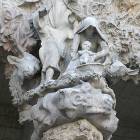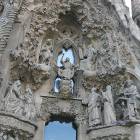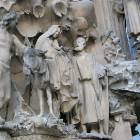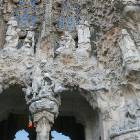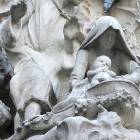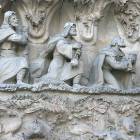The Nativity scene by Gaudi on the facade of Sagrada Familia
This is the only of the three facades made by Antoni Gaudi, and is tied to cathedral’s name – The Holy Family (Sagrada Familia). The second facade was done later in a more modern style, presenting the Passion of Christ with human figures done with rectangular shapes and mysterious portraits. The third facade, in progress now, will deal with the theme of Resurrection and God’s Glory. In contrast with the Passion facade, situated on the opposite side of the building, the Nativity facade is very traditional in appearance, in fact it is the only element with a conservative look in this entire church. This is one of the three monumental gates that will lead believers inside Sagrada Familia.
The source of inspiration for this sculptural facade is the tradition widely spread in Catholic and especially Hispanic world to depict the Christmas scene with small or life size statues of Mary, Joseph, the shepherds and the magi gathered to honor the birth of baby Jesus.
It was Gaudi’s wish that this facade would be vividly painted just like those traditional figurines, but so far it has remained unpainted. The gray cement color takes a lot of the power of expression of this statuary group, giving it a dull monotonous aspect.
The characters can be easily recognized in an imposing composition divided into three main scenes, climbing all the way to the four spires. These are just the first of the 18 towers that will symbolize Jesus, Mary, the evangelists and the apostles. In the center, the composition climbs from the Nativity scene, to the Annunciation – when Mary was told by the Angel she will give birth to Messiah – presented as an anointment, than to the scene of Coronation – a theme in Catholic art, presenting Mary as the Queen of Heavens – and ends with a green tree, hosting white doves, the symbol of the Holy Spirit. The word Sanctus is written numerous times on the four spire, repeating a word from an angelic choir.
The Holy Family, with Mary riding a donkey along Joseph is found in chronological scenes on horizontal, going to Bethlehem to take part at the census ordered by Herod, than fleeing to Egypt to escape the wrath of the Jewish king. The central scene is the classical scene of watching the infant Jesus in a stable or a cave, surrounded by oxen. The three magi and the three shepherds come to bow in front of the future king. The magi are mysterious characters who are presented in the Gospels as following a star in the heaven that announced them of an important event and than giving Jesus their symbolic gifts: gold, frankincense and myrrh. By the number of the gifts, have been deduced the number of the three magi. Tradition even gives them names: Caspar, Balthazar and Melchior. Much speculations have been made about these three wise men. Some take the account as a recognition of astrology, and consider them either kings or astrologers themselves, while others point to a religious caste of the Persian Zoroastrians. In the Spanish world the three wise men were used as characters in public ceremonies, bringing gifts to children, and only recently have they been replaced by Santa Clause.
The three shepherds who see the light of the star from outside created less fascination, but they also raised the question of the actual time of birth of Christ, whether that moment didn’t take time during spring or summer, when the herds would be outside. The date of the first Christmas is not mentioned in the Bible. The scene of the massacre of the infants by soldiers looking for a possible rival to the throne of Judea is symbolized by a soldier with sword.
Another scene presented on the facade of Sagrada Familia is that of the first entrance of Jesus into the Temple, somewhere around His 12 year. The surrounding of the entire composition is made up of luxurious plants that manage to recreate the decorative art of Gothic, with angels, palm leaves, flowers and animals emerging from the concrete walls.
- Home Page
start page - Architecture
landmark buildings - Sacred architecture
places of worship - Nature
landscape photography - Concert
performing artists - Christmas
Santa Claus pictures
- Jooble
jobs for photographers - Escape
an out of control blog - Merry Christmas
The best organizer of Christmas parties - Astro photo
Eclipse hunting and astrological photography

